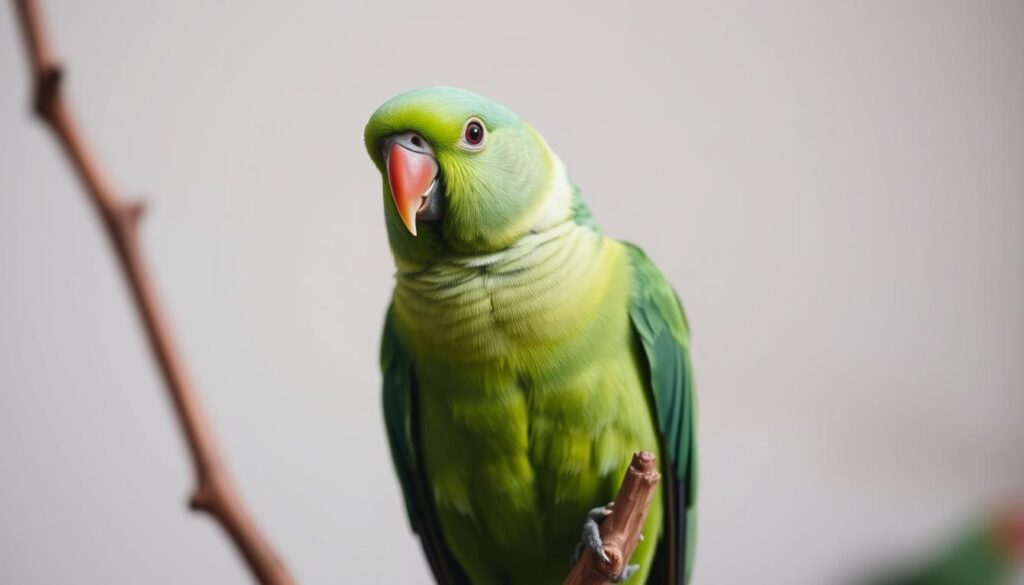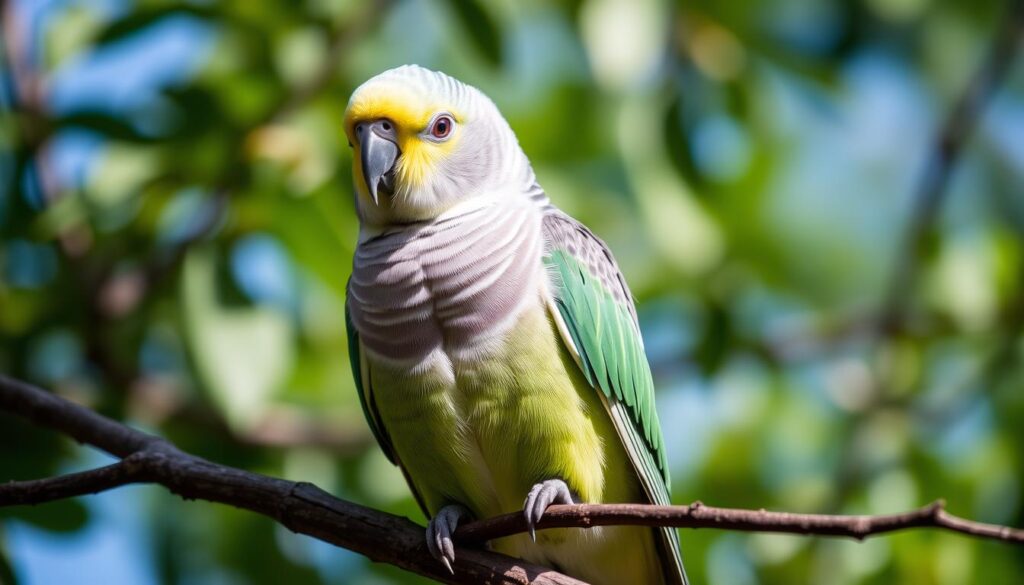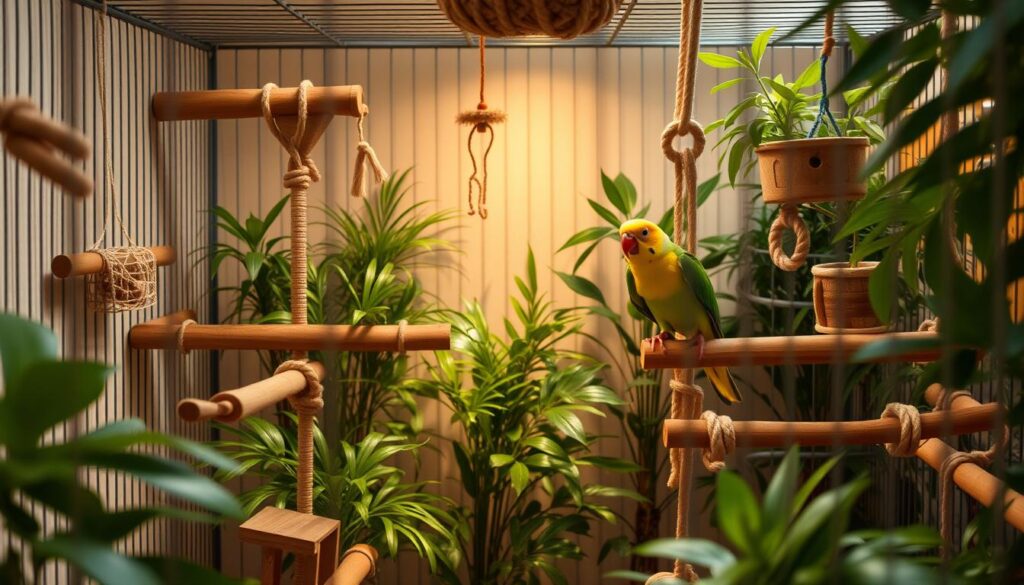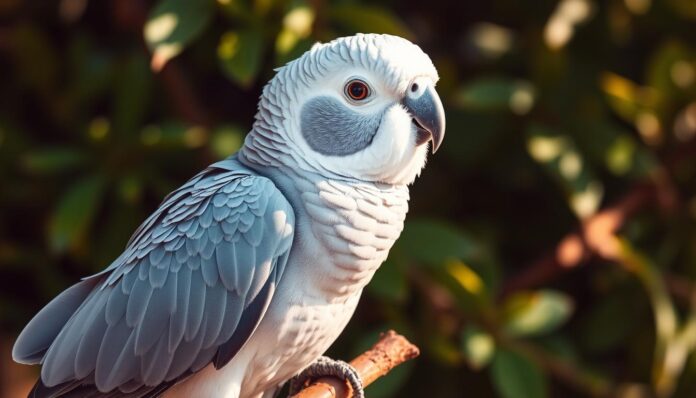Imagine having a feathered companion that is smart, playful, and loving. For many, the Quaker Parrot is the ideal pet. They bring joy and color into people’s lives with their lively personalities and smarts.
Quaker Parrots are known for being affectionate. They make great pets for those who can give them the time and care they need. Let’s learn more about these charming birds and how to care for them well.
This article will help you understand and care for your Quaker Parrot. It’s all about making sure you and your feathered friend have a happy and healthy bond.
The Fascinating World of Quaker Parrots
Quaker Parrots are smart and fun-loving, making them a favorite among bird lovers. They come from South America and can live in many places. This shows how well they adapt and survive.
Origin and Natural Habitat
Native South American Regions
These birds are from the subtropical parts of South America, especially Argentina. They live in forests, woodlands, and cities. This shows they can do well in different places.
Wild Behavior and Adaptations
In the wild, Quaker Parrots live in big groups and have complex social lives. They are good at finding food, eating seeds, fruits, and plants.
Physical Characteristics
Size and Weight
Quaker Parrots are small, about 11 to 12 inches long and weigh 3 to 4 ounces.
Distinctive Features
They stand out with their bright green feathers, a grayish chest, and a blue-green forehead. Their strong, curved beak helps them crack open seeds and nuts.
| Characteristic | Description |
|---|---|
| Length | 11-12 inches |
| Weight | 3-4 ounces |
| Plumage | Vibrant green with grayish tint on chest |
| Beak | Strong, curved |
Why Quaker Parrots Make Excellent Companions
Quaker parrots are smart and social, making them great pets. They form strong bonds with their owners. This makes them perfect for those who want a pet that’s both interactive and loving.
Social Nature and Personality Traits
Quaker parrots love to be around people. They are playful and show lots of emotions. This makes them very charming to their owners.
They need lots of attention to stay happy. This is because they are very social.
Intelligence and Problem-Solving Abilities
Quaker parrots are incredibly smart. They can solve complex problems and even use tools. This intelligence helps them learn to talk like humans.
They are a joy to talk to. To keep them happy, they need mental challenges. This is part of proper quaker parrot care.

Compatibility with Different Household Types
Quaker parrots fit well into many homes. They need owners who can spend time with them. This is important for their quaker parrot behavior.
They can live in big or small homes. What matters most is the attention they get. Their quaker parrot talking skills improve with interaction.
Understanding Quaker Parrot Behavior
Quaker Parrots have complex behavior, showing social dynamics and communication cues. They are very social and love to interact, whether with other birds or humans.
Social Dynamics and Flock Mentality
Quaker Parrots form strong bonds in their flock. This means they bond well with their human families too. They need attention, interaction, and to feel part of their “flock.”
Common Behavioral Patterns
Quaker Parrots are active and curious. They love to forage, play, and make sounds. They need mental and physical challenges to stay happy.

Body Language and Communication Cues
It’s important to understand Quaker Parrot body language. They use postures, facial expressions, and sounds to talk to each other.
Signs of Happiness
A happy Quaker Parrot is relaxed and playful. They make nice sounds and may preen themselves. These are signs they’re content.
Signs of Stress or Illness
A stressed or sick Quaker Parrot might act aggressively or pluck their feathers. They might also change how they sound. Spotting these signs early helps them get the care they need.
| Behavioral Sign | Indication |
|---|---|
| Relaxed Posture | Happiness/Contentment |
| Aggressive Behavior | Stress/Illness |
| Pleasant Vocalization | Happiness |
| Feather Plucking | Stress/Illness |
The Impressive Talking Abilities of Quaker Parrots
Quaker Parrots are famous for their amazing ability to mimic human speech. They make great companions because of this talent. Their talking skills are unmatched by most other parrots.

Vocal Range and Capabilities
Quaker Parrots have a wide vocal range. They can learn up to 50 or 60 words or phrases. Their skill in mimicking human voices shows their intelligence and is very entertaining.
Teaching Methods and Techniques
To get a Quaker Parrot to talk, start with simple words and phrases. Repeat them often. Use positive reinforcement with treats and praise to help them learn.
Setting Realistic Expectations
It’s important to set realistic expectations with Quaker Parrots. Not every bird will become a skilled talker. Their ability to mimic speech can vary a lot.
In conclusion, Quaker Parrots’ talking abilities make them special pets. Knowing how to encourage their vocal skills can be very rewarding for both the parrot and its owner.
Quaker Parrot Colors and Varieties
The Quaker Parrot’s colors are as varied as they are stunning. These birds come in many colors, captivating bird lovers everywhere.
Standard Green Quakers
The most common Quaker Parrot color is standard green. Their body is a bright green, with a lighter belly. This color helps them blend into their natural setting.
Blue Quakers
Blue Quakers are a favorite among owners. They have striking blue feathers. This color is especially sought after for its unique look.
Rare Color Mutations
Quaker Parrots also come in rare colors. Some of these include:
- Cinnamon: A warm, brownish color that makes them stand out.
- Lutino: They have a yellow or pale yellow color, often with red or pink eyes.
- Pied Variations: These have a mix of colors, like green and yellow or blue and white. They look very unique and beautiful.

| Color Variation | Description |
|---|---|
| Standard Green | Vibrant green across the body, lighter on the belly |
| Blue | Striking blue feathers |
| Cinnamon | Warm, brownish hue |
| Lutino | Yellow or pale yellow, often with red or pink eyes |
| Pied | Mix of colors, typically green and yellow or blue and white |
The variety in Quaker Parrot colors makes them even more beautiful. Whether you love the classic green or the rare colors, these birds are sure to amaze you with their beauty and charm.
Essential Quaker Parrot Care Guide
To keep your Quaker Parrot happy and healthy, you need to know what it needs. This includes a good cage, the right environment, and a daily routine.
Cage Requirements and Setup
Quaker Parrots need big cages because they love to move around. Their cage should have lots of air and room to fly.
Recommended Cage Size
The cage should be at least 2 feet wide, 3 feet long, and 4 feet tall. But, the bigger the cage, the better.
Essential Accessories
- Perches of varying diameters to keep the parrot’s feet healthy
- Toys that challenge and engage, such as puzzle toys and foraging toys
- A sturdy food dish and a water bottle or dish
Environmental Considerations
Quaker Parrots are very sensitive to their surroundings. They need certain conditions to stay healthy.
Temperature and Humidity
Keep the temperature between 65-75°F (18-24°C) and humidity at 50-60%. Don’t put their cage near cold or hot spots.
Lighting Needs
They need natural light or full-spectrum lighting. This helps them stay healthy and follow their natural day-night cycle.
Daily Care Routine
Having a daily routine is key for your Quaker Parrot’s happiness. This includes:
- Morning and evening social interaction
- Daily cleaning of the cage, including food and water dishes
- Regular health checks to monitor the parrot’s condition
| Care Aspect | Description | Frequency |
|---|---|---|
| Cage Cleaning | Thorough cleaning of the cage, including accessories | Daily |
| Social Interaction | Engaging with the parrot through play and conversation | Twice daily |
| Health Checks | Monitoring the parrot’s health and behavior | Daily |

Nutritional Needs: The Ideal Quaker Parrot Diet
Quaker Parrots need a diet full of variety and nutrients to stay healthy. A balanced diet is key to their well-being and a long, active life.
High-Quality Pellet Foundation
A high-quality parrot pellet should be the main part of their diet. These pellets have the right mix of vitamins, minerals, and proteins for their health.
Choose pellets with vitamins and minerals, and avoid those with too much corn and soy. A good pellet should make up 60-70% of their diet.
Fresh Fruits and Vegetables
Fresh fruits and vegetables are also important in a Quaker Parrot’s diet. They add nutrients, fiber, and variety, keeping the parrot happy and active.
Safe options include kale, spinach, carrots, bell peppers, apples, and berries. It’s important to give a variety every day for a wide range of nutrients.

Healthy Treats and Supplements
While pellets and fresh produce are mainstays, healthy treats can be given in small amounts. Nuts and seeds can be treats, but they should be given carefully because of their fat content.
Supplements might be needed if the diet lacks certain nutrients. Always talk to an avian vet before adding supplements to avoid imbalances.
Foods to Avoid
Some foods are toxic to Quaker Parrots and should never be given. Avoid avocado, chocolate, caffeine, and foods high in salt and sugar. Also, foods with pits or seeds, like cherries and apricots, are dangerous.
Feeding Schedule and Portions
Having a regular feeding schedule is important for a Quaker Parrot’s health. The amount of food needed varies by age, size, and activity level. Offer a measured amount of pellets daily, and give fresh fruits and vegetables throughout the day.
| Food Type | Recommended Daily Amount | Frequency |
|---|---|---|
| High-Quality Pellets | 1/4 to 1/2 cup | Daily |
| Fresh Fruits and Vegetables | 1-2 cups mixed | Daily, varied |
| Healthy Treats | 1-2 tablespoons | 2-3 times a week |
Health Considerations for Your Quaker Parrot
Keeping your Quaker parrot healthy involves proper care, good nutrition, and regular vet visits. It’s important to know about common health issues to give your bird the best life.
Common Health Issues
Quaker parrots face health problems like respiratory issues, nutritional deficiencies, and feather plucking. Early treatment can greatly improve their life quality.
Respiratory Problems
These birds can get respiratory infections from bacterial or fungal pathogens. Look out for signs like hard breathing, wheezing, or feeling tired. If you see these, see an avian vet right away.
Nutritional Deficiencies
A bad diet can cause many health problems. Make sure your Quaker parrot eats well-balanced food, including quality pellets, fresh fruits, and veggies.
Feather Plucking
Feather plucking might mean your parrot is stressed, bored, or sick. Give them a fun environment and check their health to stop this behavior.
Preventative Care Measures
Preventive care is crucial for your Quaker parrot’s health. This means regular vet visits, a good diet, and a clean, safe home. Regular vet checks can catch problems early.
Finding an Avian Veterinarian
Finding a good avian vet is key for your parrot’s health. Look for a vet who knows about parrots and birds. Ask them about their experience and how they care for birds.
| Health Issue | Symptoms | Preventative Measures |
|---|---|---|
| Respiratory Problems | Labored breathing, wheezing, lethargy | Avoid exposure to drafts, keep environment clean |
| Nutritional Deficiencies | Weight loss, lethargy, poor feather condition | Provide balanced diet, include fresh fruits and vegetables |
| Feather Plucking | Visible feather loss, stress signs | Provide mental stimulation, ensure a safe and clean environment |
Training and Socializing Your Quaker Parrot
Training and socializing your Quaker Parrot is key for their happiness and behavior. These smart birds need mental challenges, social time, and regular training to be happy.
Basic Commands and Tricks help you bond with your Quaker Parrot. Learning simple commands like “step-up” and “stay” works best with positive reinforcement. Tricks like shaking hands or fetching items are fun and keep their minds sharp.
Positive Reinforcement Techniques
Positive reinforcement is a great way to train. It links good actions to rewards like treats or praise. This builds trust and keeps your parrot healthy and happy.
Addressing Behavioral Problems
Quaker Parrots might show biting and aggression or excessive screaming. Knowing why they act this way helps fix the problem. Biting and aggression come from fear, territory, or frustration. Screaming can mean they’re bored, seeking attention, or stressed.
Biting and Aggression
To stop biting and aggression, find out what scares or upsets them. Then, slowly introduce them to the scary thing while rewarding calm behavior. This helps a lot.
Excessive Screaming
For too much screaming, make sure they’re busy and happy. Give them lots of toys, play with them, and keep a daily routine. This cuts down on screaming.
Enrichment Activities
Keeping your Quaker Parrot’s mind and body active is important. Change their toys often and play with them. Activities like finding food or solving puzzles keep them engaged and happy.
With these training and socializing tips, your Quaker Parrot will be a loving and well-behaved friend.
Preparing Your Home for a Quaker Parrot
Before you bring a Quaker Parrot home, make sure your space is ready. This means bird-proofing, creating a safe area, removing harmful items, and setting up a play zone.
Bird-Proofing Essentials
Bird-proofing is key to keep your Quaker Parrot safe. Secure loose wires, remove dangerous materials, and block off risky areas. Doing this will prevent electrical shock and other dangers.
Creating a Safe Environment
Creating a safe space for your Quaker Parrot is more than just removing dangers. It’s about making a place that’s good for them. This means a big cage, fresh air, and a comfy temperature.
Toxic Household Items to Remove
Many household items can harm Quaker Parrots. Get rid of toxic cleaners, pesticides, and some foods. Watch what you use and store to keep your parrot safe.
Setting Up a Play Area
A play area is crucial for your Quaker Parrot’s health. It should have toys, perches, and activities. Here’s a table to help you set it up:
| Toy/Activity | Purpose | Frequency of Rotation |
|---|---|---|
| Swings and ladders | Physical exercise and climbing | Every 2 weeks |
| Foraging toys | Mental stimulation and foraging behavior | Every week |
| Bells and whistles | Auditory stimulation | Every 3 weeks |
| Chewing toys | Beak health and satisfaction | Every week |
By following these steps, you can make a safe and fun home for your Quaker Parrot.
Legal Considerations for Quaker Parrot Ownership in the US
The laws about Quaker Parrots differ in each US state. It’s important for future owners to understand these laws well. They must deal with many rules about owning these birds.
States with Restrictions or Bans
Some places in the US don’t let you own Quaker Parrots. For example, California and New York have laws against owning them. It’s key for people to know the laws in their area to stay out of trouble.
Permit Requirements
In places where you can own Quaker Parrots, you might need special permits. These permits have rules you must follow. This could include how big the cage must be or if you can breed them.
Understanding the Regulations
Knowing the rules about Quaker Parrots is more than just following them. It’s also about making sure the birds are well cared for. Laws are made to stop birds from being mistreated or neglected.
Responsible Ownership
Being a good owner of Quaker Parrots means following the law and taking care of them. This includes giving them the right food, social time, and living space.
By staying informed and taking action, Quaker Parrot owners can have a great experience with their birds.
Conclusion: Is a Quaker Parrot Right for You?
Quaker Parrots can be great pets for the right person. They are smart, social, and can talk well. But, they need the right care and attention to thrive.
Think about your lifestyle and living situation before getting a Quaker Parrot. They need a good home, a balanced diet, and lots of social time. It’s also important to understand their behavior and be ready to handle any issues.
If you’re ready to care for a Quaker Parrot, they can bring a lot of joy and companionship into your life. By considering their needs and your situation, you can decide if a Quaker Parrot is the right pet for you.
FAQ
What is the average lifespan of a Quaker Parrot?
Quaker Parrots can live for about 30 to 40 years. But, with the right care, some may reach their 50s.
How big do Quaker Parrots get?
They grow to be 11 to 12 inches long. They also weigh between 3 to 4 ounces.
Are Quaker Parrots considered loud birds?
Yes, they are very loud. Their high-pitched screeching and chirping can be a problem for those in apartments or with noise rules.
Can Quaker Parrots be trained to talk?
Yes, they are known for mimicking human speech. With regular training, they can learn to talk.
What is the ideal diet for a Quaker Parrot?
They need a high-quality pellet as their main food. Add fresh fruits, vegetables, and treats now and then.
Are Quaker Parrots social birds that require a lot of interaction?
Yes, they love to be around people. They need lots of attention and interaction from their owners.
Can Quaker Parrots be kept in a small living space?
They can live in smaller spaces, but they need a big cage. They also need time outside to fly and exercise.
Are Quaker Parrots prone to any specific health issues?
Yes, they can get health problems like feather plucking and respiratory issues. Poor diet can also cause problems.
How much does a Quaker Parrot typically cost?
Prices vary based on age, color, and breeder. On average, they cost between 0 to 0.
Are there any legal restrictions on owning a Quaker Parrot in the US?
Yes, some US states have laws against owning Quaker Parrots. Always check local laws before buying.
How often should I take my Quaker Parrot to the vet?
Take them to an avian vet once a year. Go more often if you see any signs of illness.


